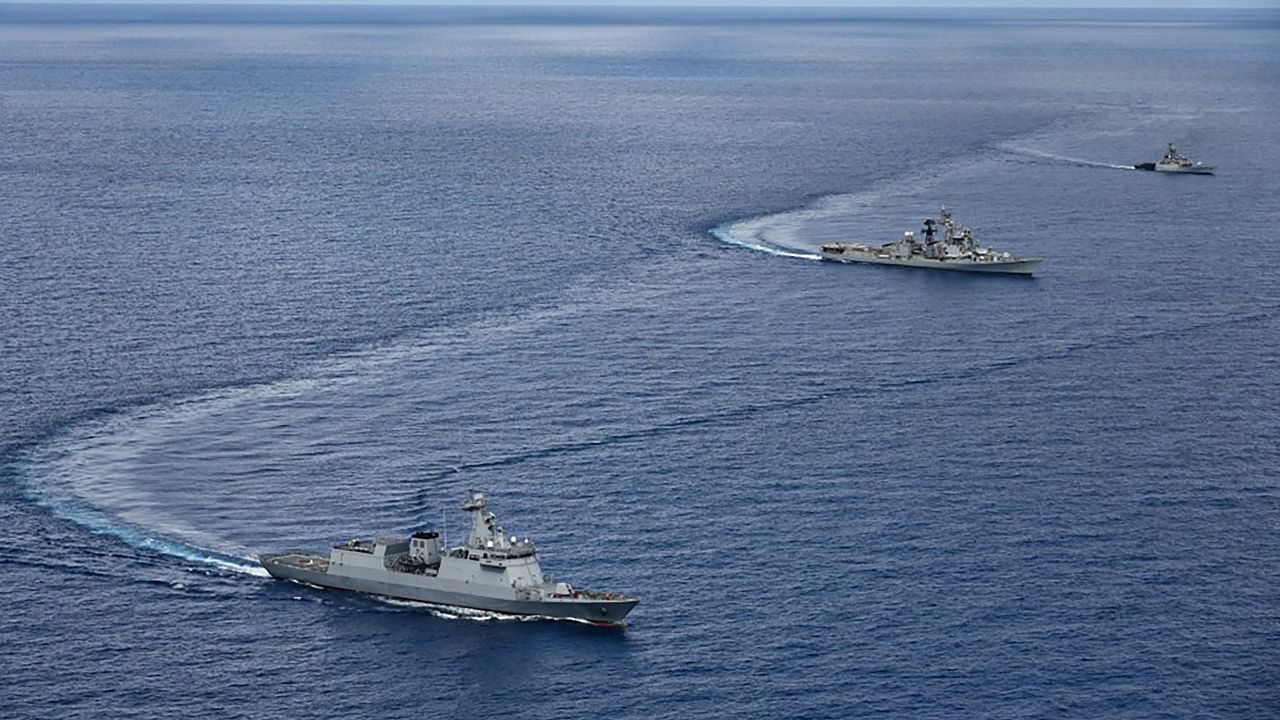
There were few surprises in the defence budget introduced as part of the Union Budget for 2022-2023 by Finance Minister Nirmala Sitharaman on Tuesday.
But there were a few small hits to be counted. The navy can take some satisfaction in exceeding its expenditure goals, with over 90 per cent already spent this year, for the modernisation and expansion of its naval and aircraft fleet.
While Rs 16,000 crore had been budgeted for 21-22, the revised budget under this head for 21-22 is 24,717 crore, and the budget for 22-23 anticipates expenditure of Rs 29,452 crore. Part of the reason is the reduction in time between milestones payments being made to manufacturers with the construction of successive warships of a class proceeding quicker.
The navy's budget for aircraft has also been revised upwards from Rs 5,511.20 crore to Rs 8,014.20 crore for this year, and it expects to spend Rs 5,925.94 crore on it in 22-23. The budgetary allocation for capital expenditure by the navy has been hiked by 44.53 per cent to Rs 46,323 crore in 22-23.
What is also interesting at the Indian Coast Guard has also seen an upward revision of its capital expenditure from Rs 2,650 crore to Rs 3,236.46 crore in 21-22 and a further year-on-year planned budgetary hike of over 60 per cent in 22-23 to Rs 4,246.37 crore.
Unsurprisingly, the capital expenditure by the Indian Air Force (IAF) on aircraft and aeroengines has seen a reduction with an initial budget for 21-22 of Rs 24,268.20 crore that rose slightly upon revision by Rs 2,461.95 crore and expects to land at Rs 18,966.18 crore in 22-23. This would likely be in part due to the completion of delivery for the fleet of 36 Rafale fighters expected later this year.
The army has been less successful in spending the money it was allotted to buy kit this year. With a kitty of Rs 36,481.9 crore, the revised budget is down to Rs 25,377.09 crore. It looks like the army will be unable to spend more than 30 per cent of its capital budget this year. Part of this might be due to the disruption in supply chains and slippage in delivery schedules that has followed the pandemic. The expenditure anticipated under this head for 22-22 is also lower than envisaged for 21-22, with Rs 32,015.26 allocated.
But the emphasis continues on shoring up border infrastructure, with expenditure on projects by the Border Roads Development Board remaining steady at Rs 3,500 crore for this year financial and the next.
Budgetary allocations are not expected to drive the general objective of restructuring and reform of the armed forces, with cuts to expenditure on manpower in favour of contemporary technologies, envisaging future conflicts. But it is mildly disappointing to see few indications of these structural reforms in the document that would reduce the emphasis on rifles and increase it on items like the Rafale.
To be sure, expenditure on an anachronism long past its utility like Military Farms has fallen significantly (from the actual expenditure of Rs 79.71 crore in 20-21 to a Rs 5.14 crore budget in 22-23 and no capital expenditure), but these amounts are too small to matter.
India can only afford the shift to the modernisation of equipment based on an appreciation of the changing technological nature of warfare and how future conflicts will be fought by reducing reliance on manpower. This simply isn't happening anytime soon.
Expenditure on the pay and allowances in the armed forces have seen a steady increase from an actual spend of Rs 1,13,189.43 crore in 20-21 to a planned budget of Rs 1,36,931.46 crore in 22-23, of which Rs 1,09,452.36 is that of the army, alone. (India spends a little less on all navy salaries than it does on the establishment cost of the Rashtriya Rifles, perhaps not entirely surprising since it consists of 65 battalions.)
But that said, while the current hike in naval and coast guard capital expenditure might not necessarily be related to a new appreciation of the potential role of maritime power in facing-off threats to India like the People's Republic of China - and certainly not away from a continental power mindset - it is an approach worth meditating upon, especially with the freeze achieved in the ongoing stand-off on the northern borders with the Chinese People's Liberation Army (PLA) with India's continued, massive deployment of troops.
The role of maritime power in deterring India's adversaries or the criticality of technology in future conflicts will remain ideas discussed in webinars, not longer-term solutions independent of how the PLA are feeling on a given day, as long as they fail to find prominence in the defence budget as evidence of a shift in approach.
(Saurabh Joshi is a journalist who runs the defence and strategic affairs website, www.strapost.com.)
Disclaimer: The views expressed above are the author's own. They do not necessarily reflect the views of DH